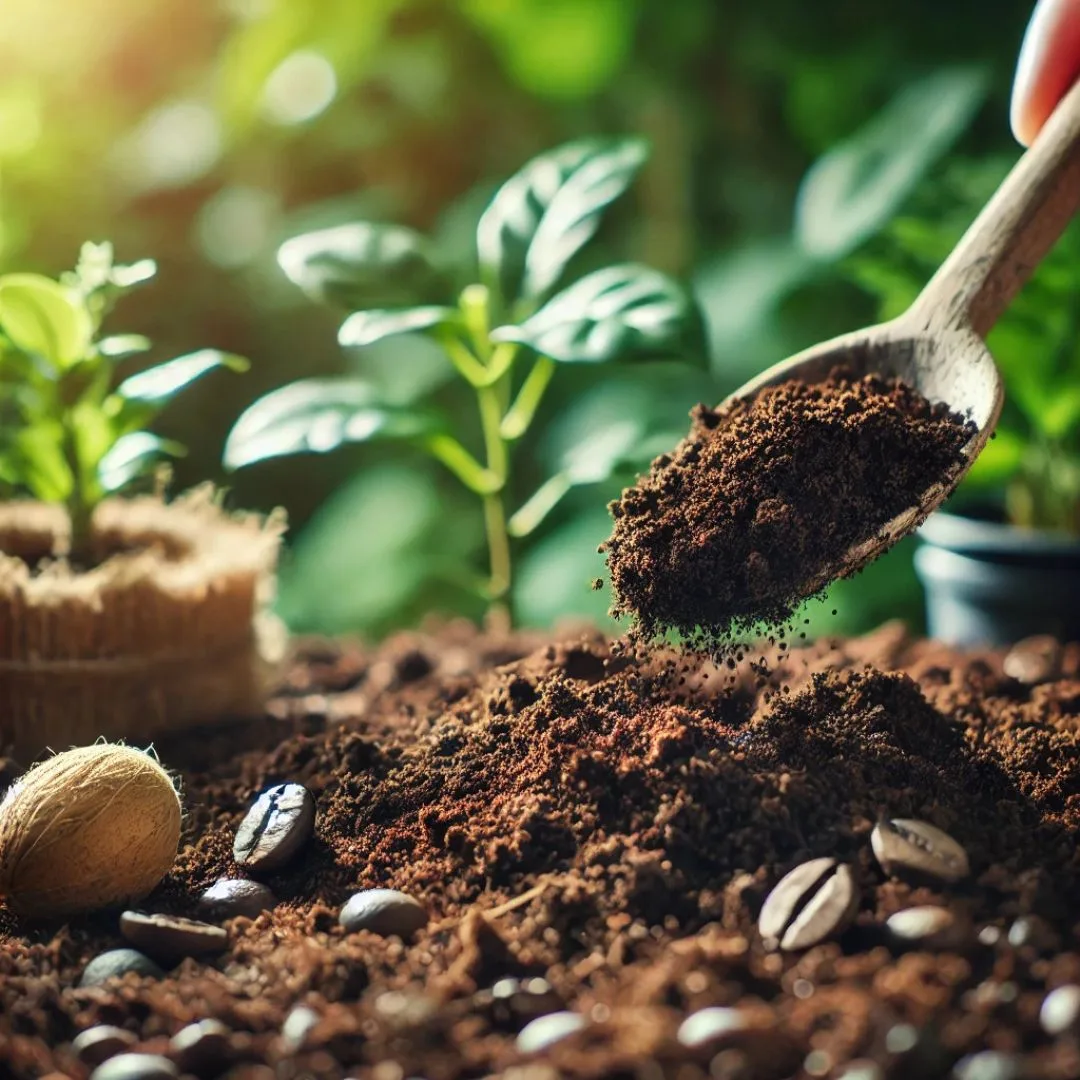Coffee is not just a beloved beverage that gets us through our mornings; it can also be a fantastic addition to your garden. But are coffee grounds really good for plants? It’s a question that many gardeners ask, and the answer might surprise you. Let’s dive into the facts and see how coffee grounds can help (or harm) your plants.
Understanding Coffee Grounds
Before deciding whether to use coffee grounds in your garden, it’s important to know what they actually are. Coffee grounds are the remnants of brewed coffee beans, left behind after your morning cup of joe. They’re rich in organic material and full of nutrients that plants can benefit from.
Composition of Coffee Grounds
Coffee grounds are made up of nitrogen, which is crucial for plant growth, as well as smaller amounts of phosphorus and potassium. These nutrients help plants thrive, particularly when used in moderation.
Nutritional Benefits of Coffee Grounds for Plants
Nitrogen Content
Nitrogen is one of the primary nutrients that plants need for leafy growth. Coffee grounds are a great source of nitrogen, making them an excellent natural fertilizer. When added to the soil, they slowly break down, releasing nitrogen that plants can absorb over time.
Phosphorus and Potassium Benefits
Phosphorus supports root development, while potassium aids in flowering and fruiting. Both of these elements are found in coffee grounds, albeit in lower quantities. However, when combined with the organic matter coffee grounds provide, they contribute to healthier, stronger plants.
Organic Matter for Soil Health
In addition to nutrients, coffee grounds add organic material to your soil. This improves soil structure, enhances water retention, and provides a home for beneficial microorganisms that promote plant growth.
Types of Plants That Benefit from Coffee Grounds
Not all plants respond to coffee grounds in the same way. Some plants thrive with the addition of this organic material, while others may suffer.
Acid-Loving Plants
Plants that prefer slightly acidic soil, like roses, azaleas, and rhododendrons, can benefit greatly from coffee grounds. The grounds’ slight acidity complements their needs, helping them grow and bloom.
Vegetables and Fruit Plants
Coffee grounds can also be useful for vegetables like carrots, radishes, and lettuce, as well as fruit plants such as blueberries. These plants appreciate the added nutrients and organic matter that coffee grounds provide.
How to Use Coffee Grounds in the Garden
There are several ways you can incorporate coffee grounds into your gardening routine. Here are some of the most effective methods.
As Mulch
You can use coffee grounds as a mulch to retain moisture in the soil and suppress weeds. Simply spread a thin layer around the base of your plants. However, be sure to mix the grounds with other mulch materials, as too many coffee grounds can compact and form a barrier that blocks water and air.
Composting with Coffee Grounds
Composting is another excellent way to use coffee grounds. They fall into the “green” category of compost materials due to their nitrogen content. Balance them with “brown” materials like leaves and straw to create a nutrient-rich compost.
Coffee Grounds as Fertilizer
Sprinkling coffee grounds directly onto the soil can act as a slow-release fertilizer. Be sure to apply them sparingly and mix them into the soil to prevent clumping.
Coffee Grounds and Soil Health
One of the biggest benefits of coffee grounds is their ability to improve soil health. Let’s take a look at how they affect soil structure and microorganisms.
Impact on Soil Structure
Coffee grounds enhance the texture of your soil by improving its ability to retain water and nutrients. This is particularly useful for sandy soils that tend to dry out quickly or clay soils that struggle with drainage.
Benefits for Soil Microorganisms
Coffee grounds feed soil-dwelling microorganisms, which play a vital role in breaking down organic matter and releasing nutrients for plant uptake. This symbiotic relationship helps create a thriving soil ecosystem.
Coffee Grounds as Pest Repellent
Did you know that coffee grounds can also help keep pests at bay? They can be a natural deterrent for some common garden invaders.
Deter Common Garden Pests
Sprinkling coffee grounds around your plants can help repel insects like ants and even larger pests like cats. The scent and texture of the grounds are unpleasant to these creatures, keeping them away from your garden.
Keep Slugs and Snails at Bay
Coffee grounds are particularly effective at deterring slugs and snails, which can wreak havoc on your plants. The grounds’ coarse texture makes it difficult for these pests to navigate.
Risks of Using Coffee Grounds
While coffee grounds offer many benefits, there are some potential risks if not used properly.
Overuse and Potential Plant Damage
Using too many coffee grounds can lead to nitrogen overload, which can harm your plants. Excessive nitrogen can burn plants or stunt their growth, so moderation is key.
Coffee Grounds and Soil pH Concerns
Though slightly acidic, used coffee grounds are generally considered to have a neutral pH. However, fresh, unbrewed grounds can be highly acidic, which may affect soil pH levels. Be cautious when using fresh grounds around plants that prefer neutral or alkaline soils.
The Myth of Coffee Grounds and Acidifying Soil
There’s a common misconception that coffee grounds make soil more acidic. In reality, used coffee grounds are closer to neutral, and their impact on soil pH is minimal. If you’re looking to significantly lower the pH of your soil, you’ll need more than coffee grounds to do the job.
Composting Coffee Grounds Effectively
When composting coffee grounds, it’s important to balance them with other materials.
Balancing Green and Brown Materials
Coffee grounds are “green” compost materials, rich in nitrogen. To prevent your compost from becoming too wet or smelly, mix them with “brown” materials like leaves, straw, or shredded paper.
Tips for Successful Composting
For best results, turn your compost regularly to ensure even decomposition. Adding coffee grounds in layers rather than dumping them all at once helps them break down more efficiently.
How Much Coffee Grounds Should You Use?
When using coffee grounds in your garden, less is often more. A thin layer of grounds spread evenly across the soil or added to your compost pile is usually sufficient.
Best Practices for Applying Coffee Grounds
Direct Application Tips
If you’re applying coffee grounds directly to the soil, be sure to mix them in well. This prevents clumping and allows the nutrients to spread evenly.
Mixing with Other Organic Materials
For best results, mix coffee grounds with other organic materials like compost or mulch. This creates a balanced nutrient profile for your plants.
Environmental Benefits of Recycling Coffee Grounds
Using coffee grounds in your garden not only benefits your plants, but it also has environmental advantages.
Reducing Waste
By reusing coffee grounds, you’re helping reduce waste that would otherwise end up in landfills. Coffee grounds are a biodegradable resource that can be put to good use in the garden.
Sustainability and Gardening
Incorporating coffee grounds into your gardening routine is a simple way to practice sustainable gardening. It’s an eco-friendly alternative to chemical fertilizers and can enhance your soil naturally.
Alternatives to Coffee Grounds for Fertilization
If you don’t have coffee grounds available, there are other natural fertilizers you can use.
Other Natural Fertilizers
Eggshells, banana peels, and grass clippings are all excellent sources of nutrients for your plants. Like coffee grounds, they’re free, biodegradable, and rich in essential nutrients.
Comparisons with Commercial Fertilizers
While commercial fertilizers can provide a quick nutrient boost, they often lack the long-term benefits of organic materials like coffee grounds. Overuse of chemical fertilizers can also damage soil health over time, whereas coffee grounds improve it.
Conclusion
So, are coffee grounds good for plants? Absolutely, when used correctly! They’re an excellent source of nitrogen, help improve soil structure, and can even repel pests. Just remember, moderation is key, and mixing coffee grounds with other organic materials will provide the best results for your garden.
Here’s some great content: can coffee stunt your growth
Can I use fresh coffee grounds in my garden?
Yes, but be cautious as fresh coffee grounds are more acidic and may affect plants that prefer neutral soil.
How often should I add coffee grounds to my compost?
You can add them regularly, but balance them with “brown” materials like leaves or straw to maintain a healthy compost pile.
Do coffee grounds attract pests?
No, in fact, coffee grounds can help repel pests like ants, slugs, and snails.
Can I use coffee grounds on all types of plants?
No, avoid using coffee grounds on plants that prefer alkaline soil, like lavender or certain succulents.
How long do coffee grounds take to break down in the soil?
It can take several months for coffee grounds to fully break down, depending on the conditions in your garden.








